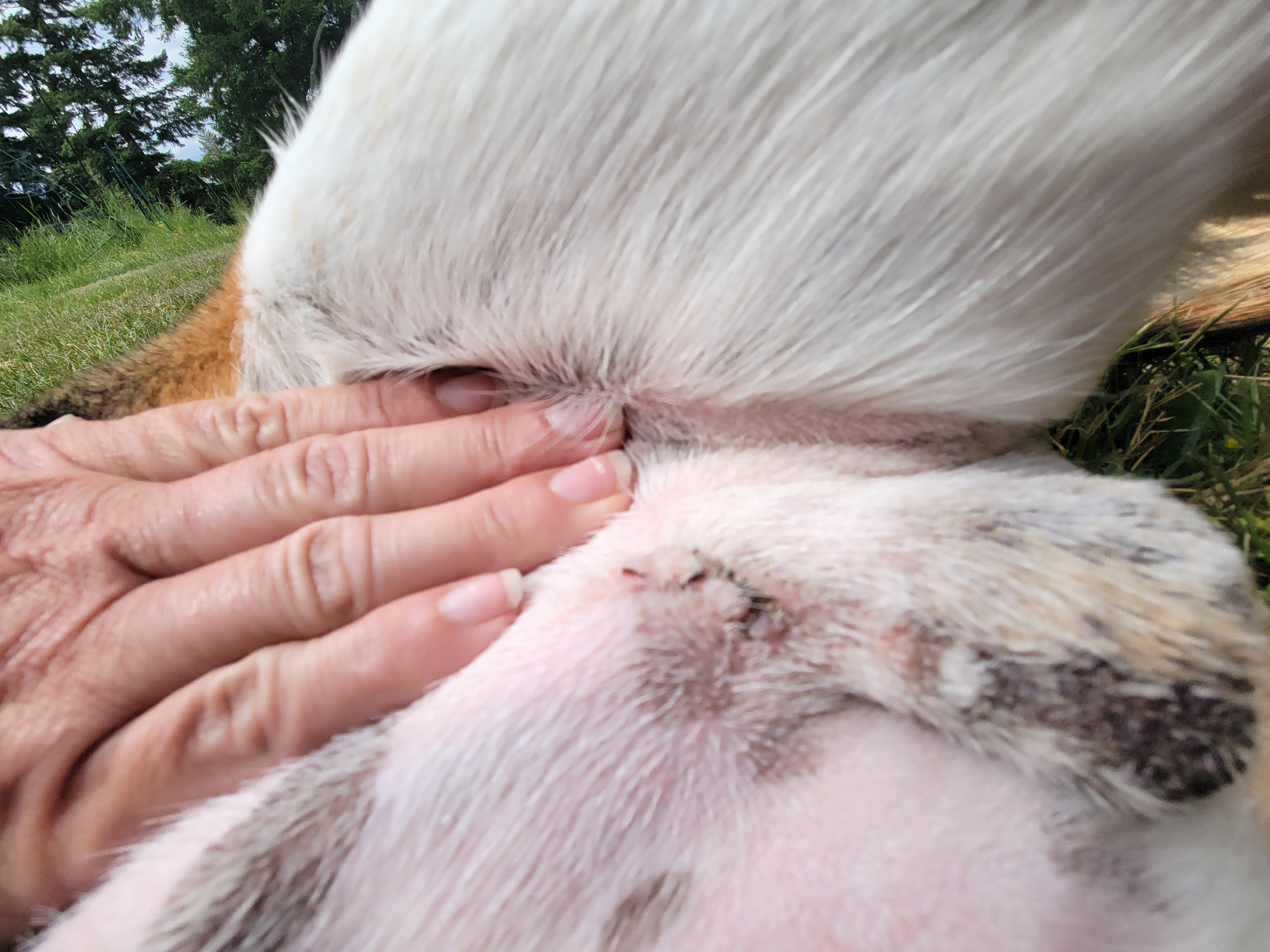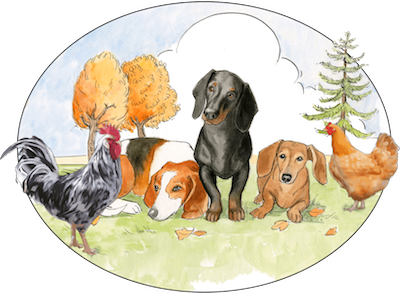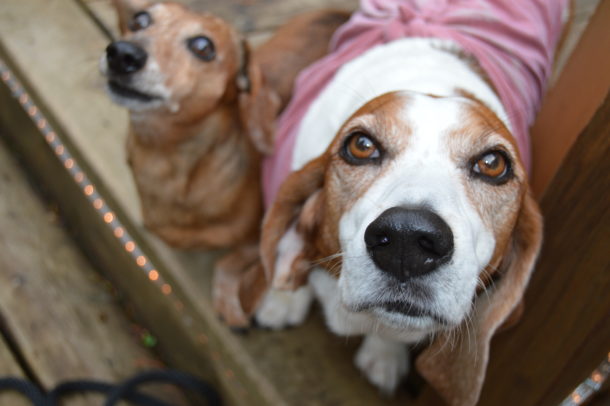10 Ways to Protect Your Dog’s Sutures After Surgery
 by Christy Caplan
|
by Christy Caplan
|
June 9, 2023
Both my dogs had surgery this year! Walter went through an epic lumpectomy, and Herschel just wrapped up two weeks of recovery after his neuter. We are so grateful both of these surgeries are behind us!
Having multiple surgeries was like a master class in how to make sure your dog’s sutures are protected and don’t get infected! A tee worked great for Walter, but the suitical did not work for Hersch…at all!
Here are various ways that you can protect your dog’s sutures post-surgery:
1. Keep your dog indoors:
Limit your dog’s movement post-surgery. Keep them indoors for the first few days following the surgery to prevent any accidental injuries. This is really important in the first 48 hours.
Everything is healing and you really want your dog to stay calm and relaxed. Only leash walks are allowed, and this may mean a conversation with your vet about a sedative. We used Trazadone with Herschel every 12 hours, and I was grateful to have that on board. We used gabapentin with Walter.
2. Use an Elizabethan collar or soft collar:
An Elizabethan collar (also known as a cone collar) will prevent your dog from licking or biting its sutures. This can be especially important if your dog is prone to chewing or licking their wounds. We had both dogs wear this collar at night.
If you’re home during the day (try to be for a few days if you can!), then you can monitor and give your dog a cone break or use the soft collar. Both dogs did much better and weren’t depressed with the soft collar. I trained Herschel to wear this for many weeks beforehand. This was instrumental in having a collar on for long periods of time! Walter is a senior and has a lot of experience wearing soft collars.
3. Monitor your dog’s behavior:
Keep a watchful eye on your dog’s behavior and movements. If you notice anything unusual, such as excessive scratching or rubbing of the wound, speak to your veterinarian immediately.
If the e-collar is the only way to avoid accidents, then use it even if you’re sitting next to your dog. I got lucky as the sedatives I used took the edge off, and neither dog wanted to lick or itch to the point where they needed the soft collar during the day.
With that in mind, never leave your dog unsupervised with that soft or Elizabethan collar – that means even if you run to use the bathroom!
4. Avoid bathing your dog:
Avoid giving your dog a bath until the sutures have healed. Bathing your dog may cause damage to the sutures and disrupt the healing process. Always ask your vet about using wound repair solutions or whether you need to check the sutures and clean the area surrounding these. If you need to use this in the beginning, find out what works best and ask them to tell you what to purchase and how to use it.
5. Keep your dog’s surrounding clean:
Keep your dog’s environment clean and free of debris that may irritate the wound or cause an infection. One way to keep the sutures clean is to have a suitical or tee on your dog. The suiticals are wonderful as they snap in place and keep the area ‘sterile’ as it doesn’t get exposed to towels, carpets, and blankets. If you live with a dog like Herschel that does not enjoy a tight-fitting suitical then try a simple tee shirt. and then tie it in a knot (think 80s) when they need to go potty outside. You can also use pee pads as the layer under your dog and replace them when they get dirty.
6. Provide a clean and comfortable recovery space:
Ensure that your dog has a clean and comfortable recovery space to rest in. Make sure the bed is free of any sharp edges that may damage the sutures. You can also add a few gates or X-pens around the area so they can rest in a small area while you get work done.
7. Reduce activity:
Reduce your dog’s activity level during the recovery period. Excessive running, jumping, and playing can interfere with healing. This is where sedatives come into play. If this feels like an impossible task and keeping your dog calm isn’t do-able after the first few days you’re home, ask your vet about post-op sedatives.
WARNING: graphic pic. This is a pic of Hersch as he was almost 14 days post-neuter. His suture site is less inflamed, the incision area is healing nicely, and everything looks good.
This was given the a-ok by our vet.
8. Follow medication instructions:
Follow your veterinarian’s prescribed medication schedule to prevent inflammation, pain, and infection. If you feel like you need more NSAIDs like carprofen or your dog is having any issues, always follow up with your vet. You can send them pics! Always finish the entire treatment plan of medications unless you notice GI upset. Call your vet!
9. Check the wound regularly:
Check the wound regularly for any signs of redness, swelling, discharge, or odor. These symptoms may indicate an infection, and prompt attention to a vet is necessary. You need to check the wound site at least once a day.
10. Attend follow-up appointments:
Suture removal and regular follow-up appointments ensure proper wound healing and prevent future complications. If your dog is like Herschel and doesn’t love his vet visits, talk to your vet about your options for follow-up. If the sutures are dissolvable, you should ask your vet about sending pics instead of an in-person visit.
I hope this is helpful! Surgery is scary for pet owners, and it’s better to be prepared and to understand what post-op looks like for you and your pup. Post-op is a big job, and it’s great if you can take a few days off after their surgery to make sure your daily routine is working and your pup is calm so they can heal.




Christie! It’s been a long time since I last saw a post from you. And how interesting that your pup had neuter surgery within a few days of my boy having had his. You probably remember me better as Ducky’s Mom.
Zen’s interior sutures are dissolvable, but our vet used surgical glue to close the skin. Last week when I was doing one of my morning checks of the site, I noticed it looked like he’d been able to reach the site to lick at it in spite of the cone (during the night). So I took a few pix with my phone. The tech called and asked if I could bring Zen by to have the vet check it later that day. Luckily the pix made it look far worse than it was. Still, for extra precaution, I’m applying Muricin to the incision site 2-3 times a day at the vet’s suggestion. It’s still a little red, but I’ve requested another follow-up appointment via the website. The Composure calming chews have been doing a pretty good job of keeping him calm during the day. I just wish – now – that I had used the Gaba/Traz from the start. (Right now I’m waiting for the calming chews to kick in – he’s making me nuts.) This boy is strong and I was afraid if the sedative worked too well, I wouldn’t be able to get him outside safely to relieve himself. I only weigh 40 lbs. more than he does.
Luckily, the breeder has had Zoey at his house for these 10-11 days (and will keep her as long as I need him to). I’m hoping to go pick her up on Tuesday. She’s been having a blast with her (and Zen’s) other doggy family so may not want to come home.
Hi! Oh my gosh – I feel like the pup has literally taken OVER. LOL – I remember sweet Ducky. Your pup is adorable. Pics are so hard, I tried to document the site very day and then I think the techs didn’t know what to do with me. I’ so glad the pic made it look worse than it was. I love Muricin and have some Animax and always forgot I can use it for incision wounds, great advice. You know I really didn’t want to use trazadone and I really resisted giving him SO much of it. I used a fairly high dose and the first day I did every 8 hours. I hated it but he’s a crazy monster and the nest day he was NOT sedate like I’m used to I guess with older dogs post-op. I also worried about that too – will he be too sedate – luckily the trazaone was just the trick and he was able to do all the things but then slept and chilled rather than jumping/freaking out.
Oh my gosh having the breeder take Zoey – for you! Our dog Walter is 12 so he doesn’t want much to do with Hersch as is but Hersch is obessessed with him and not having access to Walter reason enough to use the sedatives. 🙂 So glad to talk to you here! Glad everyting is going well. I don’t want to do that again for awhile!
Hi again! I lost sweet Ducky to a broken heart early last year, a month after her baby brother/best friend was killed by a speeding hit-&-run driver. Poor Bogie never stood a chance. It devastated us both; but it catapulted my poor hubby into the final stages of his dementia and I lost him in October. Zen was supposed to be Ducky’s new brother; but when she passed before he was born, I knew I had to get another girl. The Z Kids are 6 months and 1 day apart. And as bonded as Ducky and Bogie were. ❤️
Oh my gosh I’m so sorry. I didn’t know this – oh sweet Ducky, my heart breaks hearing this story. I’m so so sorry for the loss of your husband as well. My goodness I’m happy you have these two Z kids – I’m sure they are bringing you so much joy. My gosh, so glad to connect with you.
Hi Christy! Great post, I never thought about sedatives post surgery, good idea! I adopted a dog in October and had to get her spayed so I went through this process. She’s super high energy and had to wear the e- collar for a week! Poor thing.
Hi! How are you? Oh my gosh- honestly, I wasn’t sure we’d make it through the 14 days! I had to sedate him for many of these- and he could still do normal things so thankfully it didn’t knock him out but it did allow him to heal up – and act calmly when he’s used to SO MUCH exercise and fetching. I didn’t love having to do it – but was grateful I had these… How long did the spay incisions take to heal?